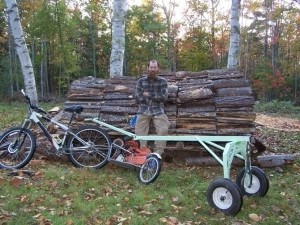
On September 25, Lora Nielsen, our Administrative Coordinator, attended the Common Ground Fair in Unity, Maine. What follows is her report.
There’s nothing like a country fair on a crisp, fall day. The combination of agricultural exhibits, livestock competitions, and maple cotton candy is hard to beat. So when I headed to Maine in late September for the Common Ground Fair, I expected more of the same. Imagine my surprise when I saw someone ride by on a bicycle with a logging winch attached to the back. .
The Common Ground Fair has been hosted by the Maine Organic Farmers and Gardeners Association (MOFGA) for the past 30 years. Formed in 1971, MOFGA is the “oldest and largest state organic association in the country.” The fair is an impressive marketplace of Maine products showcasing food, crafts, and agriculture coupled with extensive educational workshops. It also features something I doubt you’d find at any other fair: a 60-acre woodlot.
The woodlot is managed to be an example of Low Impact Forestry (hence the bicycle trailer, built to haul tools as well as the occasional small log). MOFGA uses the fair, and various other workshops throughout the year, to demonstrate to the public how a forest management plan is carried out.
When the woodlot was purchased roughly 10 years ago, it was a monoculture forest, full of even-aged, low-value pasture pine. The negative impact of this was clear: the pine was of poor quality, and no other species could break into the mix. The canopy was dense, branches vied for space, and nothing looked very robust. The woodlot team has preserved some of this original acreage so an untrained eye, like mine, can easily see the difference between a managed and unmanaged woodlot.
Nine years into their forestry plan, the parts of the woodlot that are being managed boast a young mix of fir, oak, and maple. The key to success has been the Low Impact Forestry (LIF) committee. Three times a year, including the fair weekend, a team assembles with their various saws, tractors, draft teams, portable saw mills, and knowledge, to advance another piece of the forestry plan. There are both volunteers and paid workers for the weekends, and it is obvious that they love this work.
Throughout the day there were specific talks that highlighted different stages of woodlot work. Topics included forest restoration, tree disease, woodland ecology, local energy, and chainsaw safety. There was a workshop on road and water crossings, covering both construction and animal habitat considerations. The crew was gracious and knowledgeable, taking questions with the ease of those who know their stuff and are happy to share.
During the afternoon, I got to observe the cutting and hauling of a good 30 foot tree. The limbing was fast, the measures quick, and the hauling carefully planned out. They used a draft horse for the first 8-foot log, and a tractor for the next. Before each job, a member of the team pointed out all of the considerations they were making, including what sort of mood the horses were in. An apprentice driver was given tips on how to bring his horse around to line up for the haul, without needing to go in reverse when he got there.
After hearing Nick Zandstra’s explanation of milling logs, I could easily hold court on the topic for at least five minutes. I now have a much greater appreciation for the art and the science of getting the log sliced just right. When the sawmill finishes its work, the boards are used for MOFGA building projects, or brought to market to pay for the woodlot program.
This year’s woodlot organizer, Eli Berry, pointed out that the woodlot attracts a range of people, from those who wouldn’t hurt a blade of grass to those who question why the cut is not 9 out of 10 trees, rather then a selective cut that is closer to 5 out of 10. This gives the LIF project a unique opportunity to reach a broad audience. Out in the woodlot, away from the vendors and the music, everyone’s questions get thoughtful answers.
Over the course of the day, perhaps 5 trees were felled, far fewer than would be done in a “real” logging job. While the entire woodlot could probably be logged in a solid winter month over five year cycles, saving it for these educational weekends mean that people like me get to learn how it is done. For all of us living in the Northern Forest, this is a unique opportunity to appreciate the habitat, economic, and environmental considerations inherent to sustainable forestry.
To learn more about the MOFGA woodlot and their educational opportunities, check out their web site.


Discussion *